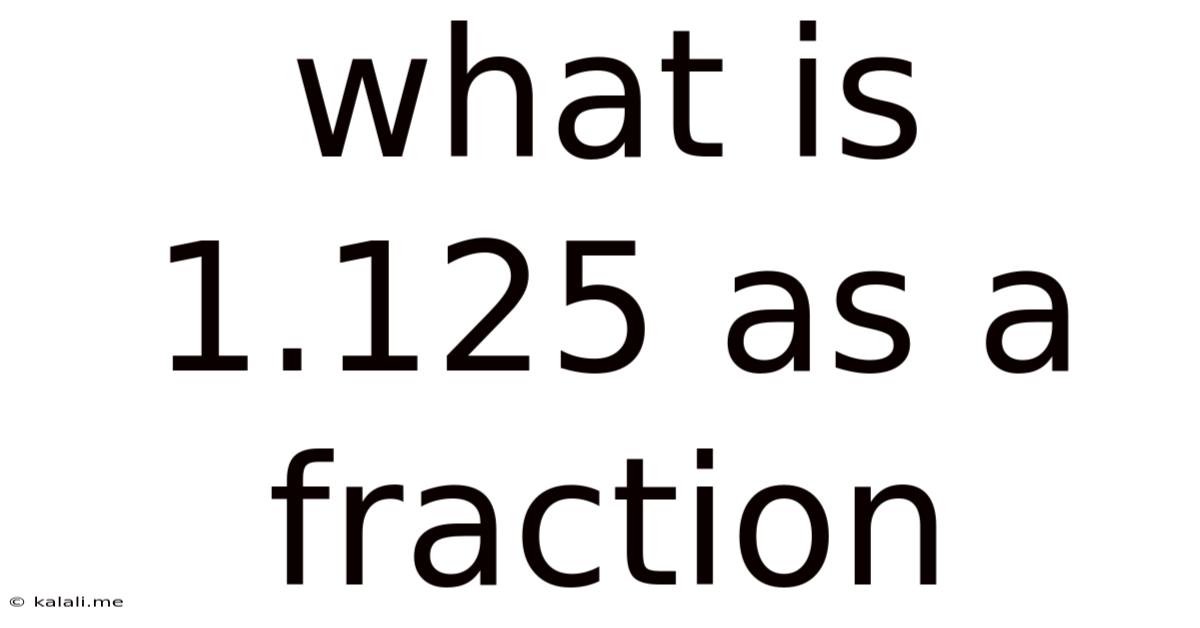What Is 1.125 As A Fraction
Kalali
Apr 08, 2025 · 4 min read

Table of Contents
What is 1.125 as a Fraction? A Comprehensive Guide
Understanding how to convert decimals to fractions is a fundamental skill in mathematics, crucial for various applications from basic arithmetic to advanced calculus. This comprehensive guide will walk you through the process of converting the decimal 1.125 into its fractional equivalent, explaining the underlying principles and offering valuable insights into decimal-to-fraction conversion techniques. We'll explore various methods, addressing common challenges and providing practical examples to solidify your understanding. This detailed explanation ensures you not only learn the answer but also master the underlying mathematical concepts.
Understanding Decimals and Fractions
Before diving into the conversion, let's briefly review the concepts of decimals and fractions. A decimal is a number expressed in the base-ten numeral system, using a decimal point to separate the whole number part from the fractional part. A fraction, on the other hand, represents a part of a whole, expressed as a ratio of two integers – a numerator (top number) and a denominator (bottom number).
The decimal 1.125 represents one whole unit and 125 thousandths of a unit. Our goal is to express this as a fraction, where the numerator represents the total number of parts and the denominator represents the total number of equal parts making up the whole.
Method 1: Using the Place Value System
This method leverages the place value system inherent in decimals. We analyze the decimal's digits based on their position relative to the decimal point.
-
Identify the decimal part: The decimal part of 1.125 is .125.
-
Determine the place value of the last digit: The last digit, 5, is in the thousandths place (10<sup>-3</sup>). This means the denominator of our fraction will be 1000.
-
Write the decimal part as a numerator: The digits to the right of the decimal point, 125, become the numerator.
-
Form the fraction: This gives us the fraction 125/1000.
-
Add the whole number: Remember the whole number 1. We can express this as a mixed fraction: 1 125/1000.
-
Simplify the fraction: To simplify the fraction, we need to find the greatest common divisor (GCD) of the numerator and the denominator. The GCD of 125 and 1000 is 125. Dividing both numerator and denominator by 125, we get:
125 ÷ 125 = 1 1000 ÷ 125 = 8
Therefore, the simplified fraction is 1/8. Adding the whole number back in, we get the final answer: 1 1/8.
Method 2: Converting to an Improper Fraction and Simplifying
This method involves first converting the decimal into an improper fraction and then simplifying.
-
Express the decimal as a fraction with a power of 10 as the denominator: 1.125 can be written as 1125/1000 (multiplying both the numerator and denominator by 1000 to remove the decimal point).
-
Find the greatest common divisor (GCD): As before, the GCD of 1125 and 1000 is 125.
-
Simplify the fraction: Divide both the numerator and the denominator by the GCD:
1125 ÷ 125 = 9 1000 ÷ 125 = 8
This results in the simplified improper fraction 9/8.
- Convert to a mixed number (optional): To convert the improper fraction 9/8 to a mixed number, divide the numerator (9) by the denominator (8). This gives us a quotient of 1 and a remainder of 1. Thus, the mixed number is 1 1/8.
Method 3: Using Equivalent Fractions
This approach involves recognizing that the decimal 0.125 is a common fraction in disguise. Many students memorize common decimal-fraction equivalents, which speeds up the process.
Knowing that 0.125 is equivalent to 1/8, we immediately add the whole number 1 to get 1 1/8. This method demonstrates the importance of memorizing frequently encountered decimal-fraction pairs for faster conversions.
Why Simplify Fractions?
Simplifying fractions is crucial for several reasons:
-
Clarity: A simplified fraction is easier to understand and interpret than a more complex one.
-
Comparison: Simplifying allows for easier comparison between fractions.
-
Calculations: Simpler fractions make subsequent calculations much easier and less prone to errors.
Practical Applications
The ability to convert decimals to fractions is essential in many real-world situations, including:
-
Baking and Cooking: Recipes often use fractions, and understanding conversions is crucial for accurate measurements.
-
Engineering and Construction: Precise measurements are vital, and converting between decimals and fractions ensures accuracy.
-
Finance: Understanding fractions is essential for handling percentages, interest rates, and other financial calculations.
Advanced Considerations: Recurring Decimals
While 1.125 is a terminating decimal (it ends after a finite number of digits), many decimals are recurring (they repeat infinitely). Converting recurring decimals to fractions requires a different approach, typically involving solving algebraic equations.
Conclusion
Converting 1.125 to a fraction is straightforward using several methods. Understanding the place value system, simplifying fractions through GCD, and even memorizing common decimal-fraction pairs are all valuable tools in your mathematical arsenal. Mastering these techniques not only helps you solve this specific problem but also equips you with the skills to tackle a wide range of decimal-to-fraction conversion challenges, strengthening your overall mathematical proficiency. Remember to always simplify your final answer for clarity and ease of use in further calculations. Practice these methods regularly to build fluency and confidence in handling decimal-to-fraction conversions.
Latest Posts
Latest Posts
-
Half A Pint Is How Many Cups
Apr 17, 2025
-
What Is A 22 Out Of 26
Apr 17, 2025
-
Cuanto Es 17 Centimetros En Pulgadas
Apr 17, 2025
-
How Many Pints In 2 Gallons
Apr 17, 2025
-
How Many Hours Is 111 Minutes
Apr 17, 2025
Related Post
Thank you for visiting our website which covers about What Is 1.125 As A Fraction . We hope the information provided has been useful to you. Feel free to contact us if you have any questions or need further assistance. See you next time and don't miss to bookmark.